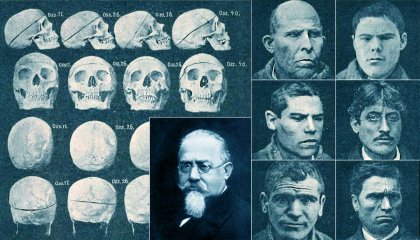Criminology is a young science. It studies four aspects of reality: crime, the criminal, the victim, and crime control. This area of knowledge was first discussed in 1885 when law professor, Raffaele Garófalo coined the term and gave it meaning. From then on, criminology became an entity in itself and started to evolve.
Throughout history, all kinds of theories have been proposed regarding crime and criminals. At one time, it was believed that criminals could be identified by their broad foreheads and large ears. There was even a time in criminology when the ‘thermal law of crime’ became popular: heat was thought to cause homicides, while cold seemed to cause robberies.
In reality, today, criminology has made great advances, both in terms of evidence, and in understanding the reasons and circumstances that lead certain individuals to commit crimes. We’re going to look at some curious facts about this interesting social science.
“Battle not with monsters, lest ye become a monster, and if you gaze into the abyss the abyss gazes also into you.”
-Friedrich Nietzsche-
Criminology and its evolution
For most of history, the means of proof available in criminology were extremely precarious. Indeed, for a long time, the only thing that could be counted on was an individual’s word. And, if they were an official or a person of higher standing, they were given more credibility than someone with a lower socioeconomic status.
Up until the eighteenth century, it was common for justice to be the responsibility of the Church, employers, unions, and institutions. They decided if someone had committed a crime. To do this, they used means that today we certainly wouldn’t approve of, such as torture.
Around the end of the 19th century, when criminology was in its infancy, there weren’t many means of evidence available. Indeed, there were no recordings, telephone records, or DNA tests as we have today. However, the investigators, who now formed part of the police force, began to use logic to determine culpability and the conditions in which a crime occurred.
Fingerprints and criminology
One of the key tools of criminology is fingerprinting. Indeed, many crimes have been discovered thanks to this technical advance. For 4000 years, signatures were used as a means of identification. However, while there was a suspicion that each individual’s fingerprints were unique, there was no way of verifying it.
It wasn’t until the 14th century that the Persian historian, Rashid al-Din Tabib, pointed out that no two people’s fingers were the same. However, his claims were ignored. In fact, it took until the mid-19th century for William Herschel, a British magistrate, to ask people to dip their hand in ink and stamp it as a signature.
He came up with this idea because when he was performing his duties in India, several of the transactions he was monitoring raised questions of authenticity. Over time, he realized that it wasn’t necessary to stamp the entire palm, but only the fingers. Later, the method was perfected and became the basis of identification systems.

Unsolved crimes
As cunning and savvy as investigators are, there are quite a few famous unsolved crimes. In fact, to date, even the advances in criminology and the dedication of detectives to try and solve many of these cases have been unsuccessful, and they remain shrouded in mystery. Perhaps one of the most legendary is Jack the Ripper, who carried out eleven murders.
Another most notorious crime was the murder of Jonbenét Ramsey. The little girl was found dead in her home in 1996 on December 26th. At first, the clues pointed to her parents. Then, it was found that there was insufficient DNA evidence to convict them. In 2006, a pedophile named John Mark Karr pleaded guilty to the crime. However, the biological tests didn’t agree. To this day, nobody knows what actually happened.
The art of criminology has also been unable to find the individual(s) responsible for a lurid homicide that occurred in Hong Kong in 1984. A citizen called the police because she saw blood seeping through the flowerbed of the next-door apartment. The authorities found two badly decomposed bodies cemented into the window box. They were chained and wrapped in a bloodstained sheet.
The victims were found to be brothers, George Chia Soon-seng and his brother, Steven. Apparently, they’d been kidnapped, and their family had paid nearly a million dollars in ransom. It’s never been discovered who committed this heinous crime. This is the world of criminology. A world that’s full of enigmas regarding the darkest side of the human being.
The post Some Curious Facts About Criminology appeared first on Exploring your mind.



















Comments